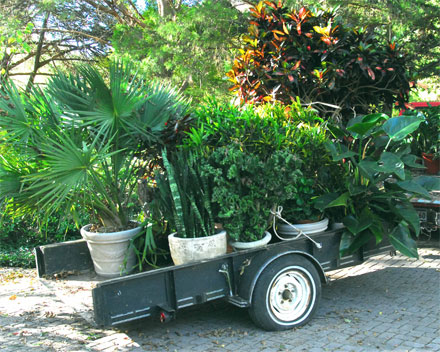From The Sperry Garden – October, 2008

Tropicals heading into the Sperry greenhouse. (Look at that tire!)
We had to scurry to get some of my old and beloved tropicals into the greenhouse before the unexpected cold weather early this week. But, truthfully, it was going to happen sometime soon anyway. They’re now inside, ready for a toasty winter before they make their return trip to the landscape next spring. This has been an annual ritual for 21 years!
From that, here are some guidelines to help you decide which of your plants you will save and how you will save them.
First and foremost: save only those plants that would be difficult to replace, either because of rarity, expense or sentimental value. Space is limited.
Second, and almost as foremost: the garage is NOT a suitable place for keeping plants for weeks or months on-end. It’s simply too cold and too dark in there. A heater might help, but it will still be way too dark. Adding lights would not make up the difference. You need a sunroom, a large window or, best of all, a greenhouse.
Some plants suffer "chilling" injury. That’s damage done by cold (but not freezing) weather. Bougainvilleas, aglaonemas, dieffenbachias and others begin to pout when temperatures drop below 45-50 F, so they need to be moved inside first. Tropical hibiscus fit into this category, too, but they often are too large to keep indoors. As with bougainvilleas, you have to decide whether you want to go to the trouble of trying to save them. You may have to do major pruning to get them inside.
Other plants will be killed by even brief exposure to 32 F. That would include most begonias, many succulents, ficuses and crotons.
Some plants can handle short-term exposure to very light freezes. That would include some non-vining philodendrons such as Philodendron selloum and some types of aloes. However, you never really know how much cold a plant can take, and you don’t know if the temperatures will drop lower than expected, so be forewarned.
Regarding Bananas And Caladiums …
Finally, to address two specific plants, I get a ton of questions on how to save bananas and caladiums each fall, and I have included the answers in the 100 Most-Asked Questions on our website. Click on either plant to see the details.

